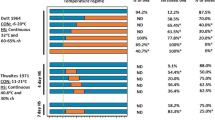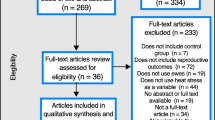Abstract
Percent of ova fertilized was significantly (P<0.01)lower in ewes exposed to 32‡C temperature on the twelfth day of the cycle before breeding (40.7.% vs 94.2% for controls). The average rectal temperature of the ewes was increased 1.7‡C within 24 hr after exposure to the elevated temperature. Morphologically abnormal ova were increased from 3.8% in control ewes to 55.6% in treated ewes. In ewes exposed to the 32‡C one day after breeding all ova were cleaved,but 30.8% were morphologically abnormal. In control ewes 87.5% lambed,but none of the ewes exposed to 32‡C before or at time of breeding lambed. In ewes exposed to 32‡C at 1, 3,5 or 8 days after breeding, 20%, 35%, 40% and 70%, respectively, lambed.Embryo mortality was significantly (P<0.01) higher for all treated ewes except those in the 8-day group.The sheep zygote is most sensitive to the harmful effects of high ambient temperature during the initial stages of cleavage before it enters the uterus.
Zusammenfassung
Die Zahl befruchteter Eier von Schafen, die vor dem Decken am 12. Tage des Zyklus einer Temperatur von 32‡C exponiert wurden, war signifikant niedriger(40,7%)als bei Kontrolltieren (94,2%) 24 Stunden nach übergang in die höhere Temperatur war die Rektaltemperatur 1,7‡C höher als vorher.Der Anteil morphologisch abnormaler Eier bei den Kontrollen betrug 3,8%, bei den exponierten Tieren 55,6%. Bei Tieren,die einen Tag nach dem Decken 32‡C exponiert wurden, zeigten alle Eier Teilung,doch davon waren 30,8% morphologisch abnormal. Von den exponierten Tieren lammte keines, von den Kontrolltieren 87,5%. Von Schafen, die 1, 3, 5 oder 8 Tage nach dem Decken 32‡C exponiert wurden, trugen 20, 35, 40 und 70% aus. In allen exponierten Gruppen war die MortalitÄt signifikant höher (P<0,01) — ausser in der 8-Tage Gruppe — als bei Kontrollen. Die Zygote des Schafes ist Äusserst empfindlich gegen hohe Temperatur wÄhrend der Initialstadien der Teilung, ehe sie in den Uterus gelangt.
Resume
La proportion d'ovules fécondés a été trouvée significativement moindre (P<0,01) chez des brebis exposées à une température de 32‡C lors du 12ème jour du cycle précédant l'insémination que chez des animaux-témoins (40,7% contre 94,2%).Pendant les 24 heures consécutives à l'exposition à la chaleur, la température rectale des brebis dépassait de 1,7‡C sa valeur au cours de la période précédente.La proportion d'ovules morphologiquement anormaux était de 3,8% chez les animaux-témoins contre 55,6% chez les animaux exposés à la chaleur. Chez des animaux qui avaient été exposés à une température de 32‡C le lendemain de l'insémination, tous les oeufs étaient segmentés, pourtant 30,8% d'entre eux présentaient des anomalies morphologiques.Desbrebis ainsi exposées, aucune n'a conduit sa gestation à terme alors que 87,5% des animaux-témoins ont agnelé. Des brebis exposées à la chaleur 1, 3, 5 ou 8 jours après l'insémination, respectivement 20, 35, 40 et 70% ont mené leur gestation à terme. Dans tous les groupes exposés, la mortalité embryonnaire a été significativement plus élevée (P<0,01) que chez les témoins, à l'exception toutefois du groupe exposé 8 jours après l'insémination. Dans l'espèce ovine, le produit de la fécondation est très sensible à 1'hyperthermie pendant les premiers stades de la segmentation qui précèdent son entrée dans l'utérus.
Similar content being viewed by others
References
ALDRED, J.P., STOB, M. and ANDREWS, F.N. (1961): Effect of high temperature, chlorpromazine and progesterone upon embryonic survival in the mouse. J.Animal Sci., 20: 964 (Abstr.).
ALLISTON, C.W., EGLI, G.E. and ULBERG, L.C. (1961): Loss of potential young in the ewe due to high ambient temperature. J.appl.Physiol., 16: 253–256.
ALLISTON, C.W. and ULBERG, L.C. (1961): Early embryonic loss in sheep at ambient temperatures of 70‡F. and 90‡F.as determined by embryo transfer. J.Animal Sci., 20: 608–613.
DUTT, R.H. (1954): Fertility rate and embryonic death loss in ewes early in the breeding season. J.Animal Sci., 13: 464–473.
DUTT, R.H., ELLINGTON, E.F. and CARLTON, W.W. (1959): Fertilization rate and early embryo survival in sheared and unsheared ewes following exposure to elevated air temperature. J. Animal Sci., 18: 1308–1317.
DUTT, H.H. and SIMPSON, E.C. (1957): Environmental temperature and fertility of Southdown rams early in the breeding season. J.Animal Sci., 16: 136–143.
FERNANDEZ-CANO, L. (1958): Effect of changes in body temperature and hypoxia on pregnancy in adrenalectomized rats. Fertility and Sterility, 1: 460–463.
GREEN, W.W. and WINTERS, L.M. (1945): Prenatal development of the sheep. Minn. Agr. Exp. Sta. Tech. Bul. No. 169, 1–36.
HART, D.S. (1956): Sources of loss in the unfertilized and fertilized sheep's ova. Proc. New Zealand Soc. Animal Prod., 16: 101–112.
HILDER, R.H., FOHRMAN, M.H. and GROVES, R.R. (1944): Relation of various factors to the breeding efficiency of dairy animals and to the sex ratio of the offspring. J.Dairy Sci., 27: 981–992.
HULET, C.V., VOIGTLANDER, H.D., POPE, A.L. and CASIDA, L.E. (1956): The nature of early-season infertility in sheep. J.Animal Sci., 15: 607–616.
McKENZIE, F.F. and TERRILL, C.E. (1937): Estrus, ovulation and related phenomena in the ewe. Mo.Agr.Exp.Sta.Res.Bul. No. 264, 24–36.
MERCIER, E. and SALISBURY, G.W. (1946): Effect of season on spermatogenic activity and fertility of dairy bulls. Cornell Vet., 36: 301–311.
OGLE, C. (1934): Adaptation of sexual activity to environmental stimulation. Am.J. Physiol., 107: 628–634.
SHAH, M.K. (1956): Reciprocal egg transplantation to study embryo-uterine relationship in heat-induced failure of pregnancy in rabbits. Nature (Lond.), 177: 1134–1135.
STEEL, R.D.G. and TORRIE, J.H. (1960): Principles and Procedures of Statistics. McGraw-Hill, New York, pp. 371.
STOTT, G.H. and WILLIAMS, R.J. (1962): Causes of low breeding efficiency in dairy cattle associated with seasonal high temperatures. J.Dairy Sci., 1369–1375.
SUNDSTROEM, E.S. (1927): The physiological effects of tropical climate. Physiol.Rev., 7: 320–362.
VELARDO, J.T. (1957): Action of adrenocorticotropin on pregnancy and litter size in rats. Am.J.Physiol., 191: 319–322.
YEATES, N.T.M. (1953): The effect of high air temperature on reproduction in the ewe. J.Agr.Sci., 43: 199–203.
Author information
Authors and Affiliations
Additional information
The investigation reported in this paper is in connection with a project of the Kentucky Agricultural Experiment Station and is published with the approval of the Director.
Rights and permissions
About this article
Cite this article
Dutt, R.H. Detrimental effects of high ambient temperature on fertility and early embryo survival in sheep. Int J Biometeorol 8, 47–56 (1964). https://doi.org/10.1007/BF02186927
Received:
Issue Date:
DOI: https://doi.org/10.1007/BF02186927




